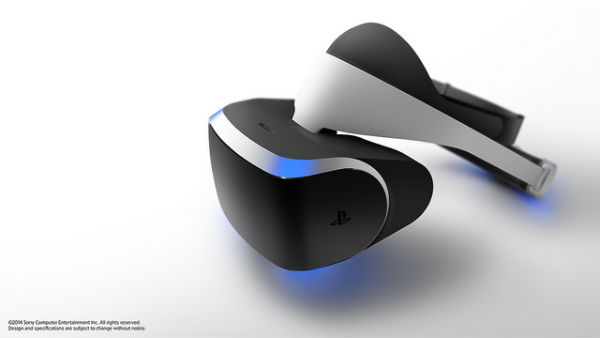Sony's Innovation, Dedication, or Lack Thereof
by Zeus | 2014-03-22
Earlier this week, Sony revealed their new PS4 virtual reality helmet. Project Morpheus is a revolutionary device that will no doubt astound lucky users with next-generation virtual reality technology, or at least it might have if they hadn't already tried out the Oculus Rift.

Guys. Guys. Morpheus is totally different than Oculus. The name may sound alike, but it's a different Latin word. And trust us, we should know. Sony names all of our hardware after Latin words.
(Image credit: PlayStation.Blog.)
Every time a company moves forward with some bold new technology, Sony is quick to tell us they thought of it first. It happened with the Wii, and it's happening again with the Oculus Rift. On one hand, I don't doubt they're telling the truth. Sony is a big company, I'm sure R&D is well funded. But the fact is, all this super secret Sony tech rarely sees the light of day until one of their competitors dips a toe, tests the waters and dives head first. Only then does Sony dare to make a splash, all the while assuring us they came up with the bellyflop back in the 80s.
Sony's motto seems to be, "Nice idea, glad I thought of it." Nintendo is their favorite source of inspiration. One need only look at a gallery of past controllers: The SNES gamepad became the PlayStation gamepad. Analog joysticks were the stuff of dreams and flight sims -- at least until Nintendo shrunk them down and introduced analog sticks as part of their gamepad. As did Sony, soon after. Then came Nintendo 64's Rumble Pak, which became an industry standard, as seen in the DualShock.
Console cameras and motion controls were available back on the Game Boy and NES respectively. But since neither caught on, Sony had no reason to really get behind the EyeToy, a device that combined cameras and motion control way back in the PS2 era. The EyeToy was considered little more than a novelty. That's one of the reasons Phil "Heretic" Harrison left Sony in 2008. According to him, he had long pushed for more casual games that utilized the EyeToy, and Sony just didn't care. In their eyes, motion controls were baby time frolics.
Today's motion control may be higher quality, but it's not nearly as rad.
Then along comes Wii, and suddenly the EyeToy was ABSOLUTELY INTEGRAL to your Family's Living Quarters. It was bundled with two lollipop wands, renamed the Move, and became the future of blah blah blah blah blah. At least for about six months, before Sony lost interest. (It's hard to think of a popular Move game, only games that are "better with Move," if you know what I'm saying.)
It's not like Nintendo was the first to do any of this, they're not PARC, in other words. But they are a bit like Apple, the first to really push this new technology on the consumer. I guess that makes Sony Microsoft in this analogy. They see a newly proven technology and can't wait to jump onboard themselves. "Tablet computers? Who'd want that?" Then three years later: "OMG GUYS THE SURFACE IS THE BEST!"
One of the reasons Wiimote set the world on fire, if not the main reason, was that Nintendo said: We believe in this, and if you want to play Mario games, you have to use it. So there, neiner neiner. There was just no way around the Wiimote, so gamers were like, what the hell, might as well give this a try. The Move and Kinect were both later additions, shoehorned into existing consoles long after the best games were designed around traditional gamepads. The Move and Kinect didn't (temporarily) unite a userbase around motion controls, they fragmented it, into the Haves and the Care-Nots.
Misguided though they may be, Microsoft has thrown its entire weight behind the Kinect. Sony (and Nintendo!) stopped packing motion controls with their next-gen consoles, but Microsoft is still out there trying to make fetch happen. And after several years and untold millions of dollars, all their hard work has been justified: You can finally navigate Netflix via voice commands.
Sony can adapt to a changing landscape, but they're hardly homesteaders, let alone pioneers. I just don't think Morpheus will be anything more than a fad. It's their way of one-uping Xbox One, justifying the continued existance of the Move, and glomming on to the Oculus Rift's potential success. And a success it could be. After all, Oculus Rift has John Carmack, ace programmer of all things Doom, who resigned his cushy position at ZeniMax because they didn't believe in the Oculus Rift. But John Carmack does believe, and if he has his way, we'll finally have high quality, affordable VR for the home. The future is bright, and popping out of the goddamned screen.
So of course, here comes Sony. Makers of all those 3D TV sets that revolutionized the way we watched moves, because Avatar. Now that everyone's excited about VR, Sony has brushed off their dusty Move (née EyeToy) and have forcibly inserted it into the Matrix.
Sony's hardware tend to rank on the high end of the scale. The PlayStation Move Controller is, by most accounts, far more accurate than either the Wiimote Plus or Xbox 360 Kinect. But despite their superior technology, Sony seems the least interested in actually getting much use out of motion controls. Even if we forget the Sixaxis -- hey, they did -- it's hard to argue: Sony didn't do a lot with the EyeToy, until it was rebranded the Move. And even then, they didn't do much with the Move, which is apparently now being repurposed as a Project Morpheus.
I'm sure Sony's VR technology will be as good, if not better, than the Oculus Rift. But it's not their technology I'm worried about.

